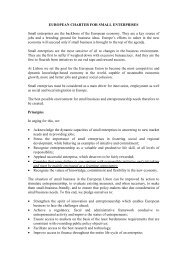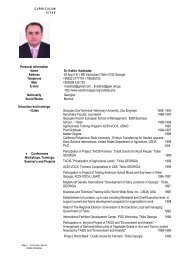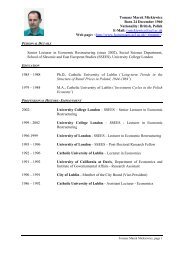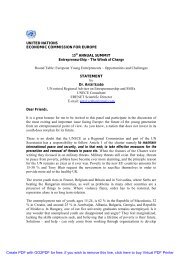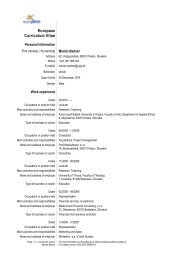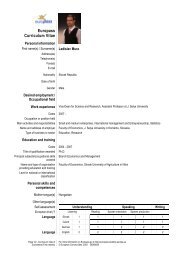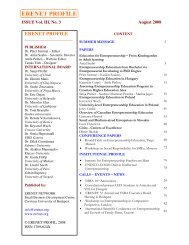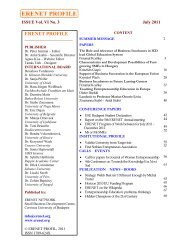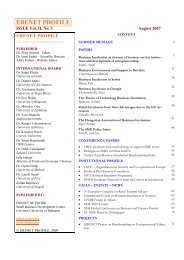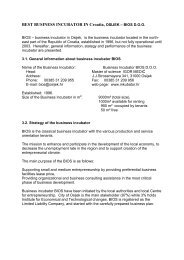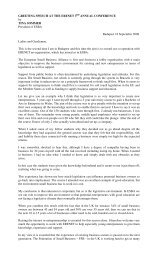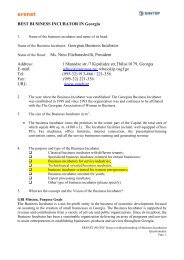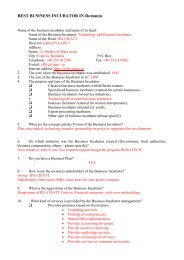Strategies of the Development of Entrepreneurship and SME
Strategies of the Development of Entrepreneurship and SME
Strategies of the Development of Entrepreneurship and SME
You also want an ePaper? Increase the reach of your titles
YUMPU automatically turns print PDFs into web optimized ePapers that Google loves.
3. Hamel, G., Prahalad, C.K. (1994), Competing for <strong>the</strong> Future: Breakthrough <strong>Strategies</strong> for SeizingControl <strong>of</strong> Your Industry <strong>and</strong> Creating <strong>the</strong> Markets <strong>of</strong> Tomorrow, Harvard Business Press, Boston,MA.2. H<strong>of</strong>stede G. 2001 Culture's Consequences: Comparing values behaviors institutions <strong>and</strong>organizations across nations 2 nd edition. Sage. Thous<strong>and</strong> Oaks3. Mintzberg, H. The rise <strong>and</strong> fall <strong>of</strong> strategic planning, Prentice-Hall, Hemel Hempstead, UK (1994).4. Ralston, D. et al, 2005. How do you climb <strong>the</strong> corporate ladder? A multi-regional analysis <strong>of</strong> <strong>the</strong>ethical preferences for influencing superiors. Academy <strong>of</strong> Management Best Papers Proceedings<strong>and</strong> International Division Best Paper Finalist, Honolulu, HI5. Porter, M. (1979) "How competitive forces shape strategy", Harvard business Review, March/April1979.6. Porter, Michael, 1990. The Competitive Advantage <strong>of</strong> Nations. New York: Basic Books.7. Scott, W. R. (1995 <strong>and</strong> 2001). Institutions <strong>and</strong> Organizations. Thous<strong>and</strong> Oaks, CA, Sage8. World Transparency Year Book 2006http://www.transparency.org/news_room/in_focus/2006/cpi_2006__1/cpi_table9. GNI, Atlas method, WDI-200610. http://devdata.worldbank.org/wdi2006/contents/Statisticalmethods.htm5. PREVENTING CONFLICT IN CAUCASUS VIA ENTREPRENEURSHIP AND <strong>SME</strong>DEVELOPMENT – REVIEW OF THE <strong>SME</strong> SECTORS IN ARMENIA,AZERBAIJAN AND GEORGIA 215.1 CHARACTERISTICS OF THE CAUCASIAN TRANSITION ECONOMIESThe three countries <strong>of</strong> <strong>the</strong> South-Caucasus: Armenia, Azerbaijan <strong>and</strong> Georgia lie to <strong>the</strong>south <strong>of</strong> <strong>the</strong> principal Caucasian mountain range, <strong>and</strong> situated on <strong>the</strong> crossroads betweenEurope <strong>and</strong> Asia <strong>the</strong>y absorbed <strong>the</strong> culture <strong>of</strong> both <strong>and</strong> cannot to this day decide with which<strong>the</strong>y have greater affinity. All three were absorbed after 1917 by <strong>the</strong> Soviet Union <strong>and</strong> weremade to bear <strong>the</strong> effect <strong>of</strong> 70 years <strong>of</strong> Soviet rule. Toge<strong>the</strong>r with <strong>the</strong> o<strong>the</strong>r republics <strong>the</strong>ygained independence in 1991.Armenia was highly industrialized <strong>and</strong> specialized in high technology sectors, such aschemicals, electronics, s<strong>of</strong>tware <strong>and</strong> engineering, whose production was exported to <strong>the</strong> o<strong>the</strong>rSoviet Republics, making Armenia vulnerable to events elsewhere. Human capital was highlydeveloped, income equitably distributed, <strong>and</strong> most social indicators (life expectancy, literacy)high; business skills, however, were in short supply.Azerbaijan was famous for its mineral resources (mainly oil <strong>and</strong> gas), with fertileagricultural l<strong>and</strong>, <strong>and</strong> a well-educated labour force with a strong entrepreneurial tradition.Georgia exported agricultural products <strong>and</strong> imported energy-intensive industrialproducts from respectively to <strong>the</strong> former Soviet Union <strong>and</strong> was a popular tourist destination for<strong>the</strong> region.The Caucasus has always been considered a significant strategic <strong>and</strong> geopolitical region.And discovery <strong>of</strong> oil on <strong>the</strong> Caspian Sea shelf not only put <strong>the</strong> Caucasus on <strong>the</strong> map as one <strong>of</strong><strong>the</strong> most economically important regions in <strong>the</strong> world. Despite <strong>the</strong>se economic gains, <strong>the</strong>region continues to face ethnic problems, which may play a negative role in <strong>the</strong> oil industry,<strong>and</strong> cause great concern over <strong>the</strong> future transport <strong>of</strong> oil to <strong>the</strong> global markets. Indeed allconflicts have <strong>the</strong>ir historical, social, economic <strong>and</strong> o<strong>the</strong>r roots. Yet <strong>the</strong> ongoing ethnic conflictin <strong>the</strong> Caucasus is <strong>the</strong> result <strong>of</strong> o<strong>the</strong>r, specific geopolitical factors. As a bridge between Asia <strong>and</strong>Europe, <strong>the</strong> Caucasus is also a frontier separating Christian <strong>and</strong> Muslim worlds. For a long time,21 Prepared by Dr. Antal SZABÓ, UNECE retired Regional Adviser on <strong>Entrepreneurship</strong> <strong>and</strong> <strong>SME</strong>s <strong>and</strong> Dr. AnnaPetrosyan, Expert <strong>of</strong> <strong>the</strong> <strong>SME</strong> Department <strong>of</strong> <strong>the</strong> Ministry <strong>of</strong>84



